Flown writing instruments from the Mercury, Gemini & Apollo missions |
||||||||||||||||||||||||||||
|
The issue of writing in space is complicated for several reasons. The absence of gravity makes the use of regular pens difficult since most rely on a gravity-feed effect to make ink flow down to the nib. A zero-g environment also means that a loose pen or pencil can drift around the spacecraft cabin, either getting lost, or worse, interfering with vital equipment in the spacecraft. A further complication of the spacecraft environment is that the astronauts often need to wear pressure suit gloves, making gripping and manipulating a writing instrument a challenge. There is a popular urban myth regarding NASA and the Space Pen which implies that they spent a fortune developing a special pen to write in space whilst the canny Russians simply used a pencil. As noted in Dwayne A. Day's excellent Space Review article "The billion-dollar space pen" there is no truth behind this legend since the famous Space Pen was developed privately, not by NASA, and American astronauts, like their Russian counterparts, actually used pencils to write in space from the earliest flights. Below I have attempted to put together a brief illustrated guide to the writing instruments known to have been used on the Mercury, Gemini and Apollo missions. This is aimed primarily at collectors of space-related artifacts - crew members on the M-G-A flights were typically allowed by NASA to keep these flown writing instruments as souvenirs after the mission, and a small number of these pens and pencils have found their way to auction in recent years, as noted below. |
||||||||||||||||||||||||||||
Grease Pencils - Mercury ProjectThe first Mercury astronauts carried standard refillable grease pencils (also known as chinagraph pencils) on their flights. These grease pencils proved fairly inaccurate to work with and not easy to grip with a pressure suit glove and a better solution to the problem of writing in space was actively sought for later flights and for the Gemini project. Availability - I've not seen a Mercury-flown pencil offered for sale, although I may have missed one in a past auction. Grissom's grease pencil was found when Liberty Bell was recovered, and is now on display at the Kansas Cosmosphere. | ||||||||||||||||||||||||||||
Scripto Mechanical Pencils - Mercury, Gemini and early ApolloThe National Air & Space Musuem collection includes a map and data pad and a note pad from John Glenn's Friendship 7 flight, both of which have mechanical pencils attached to them. These can be identified from the photos as standard Scripto Classic mechanical pencils. In order to prevent the pencils floating away in a zero-G environment, the data pad pencil (a black Scripto) is attached to the pad by a springy plastic cord and the note pad pencil (a red Scripto) is attached by a nylon cord. For the Gemini project, it is noted in Dwayne A. Day's Space Review article that standard Scripto Classic mechanical pencils from an office supply shop were acquired but modifications were thought necessary to make them safe and practical for use in a spacecraft. The two main issues to be resolved were preventing them from getting lost in a zero-G environment, and making the pencils easy to grip in a pressure suit glove. To make the pencil easier to grip in a space suit glove a special large casing was developed which was to be fitted over the barrel of the pencil. To hold the pencil in place, and to prevent it from drifting out of an open hatch during those Gemini missions with EVAs planned, NASA developed a special fitting that included a spring-loaded reel with a nylon cord which attached to the end of the pencil. One of these fittings was attached to each side of the Gemini spacecraft. It may be that these devices were actually introduced part way through the Mercury program, since one example identified as flown on Scott Carpenter's MA7 flight was sold at a Superior auction in 1994. Despite NASA's investment in this system, Grissom and Young reportedly took a further four mechanical pencils on the Gemini 3 flight. These were standard Pentel models, a fact which could have caused some embarassment to NASA given the widely-reported cost (approx $129, or $870 adjusted for inflation, per pencil) associated with the development of the special holders and casings for the official pencils. Several examples of flown Scripto mechanical pencils sold at auction were wrapped in tightly-wound nylon cord. This includes John Young's Gemini 3 pencils (one of which is shown below), Cooper's Gemini 5 pencil sold at Swann's 2005 auction, and Aldrin's Gemini 12 flown Scripto sold at Superior's Spring 1997 auction. 
One of John Young's Gemini 3 flown Scripto mechanical pencils 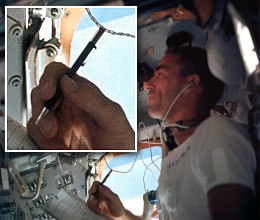
Walt Cunningham using a Scripto mechanical pencil on Apollo 7. This one appears to be missing the velcro wrapping from the end It is not clear whether these particular pencils were examples used in the special fittings or whether these were examples carried separately, but the presence of the wrapping (which presumably made them easier to grip in a gloved hand) would tend to imply the latter. Although the special retractible pencil fittings continued to be installed on the Gemini spacecraft, unmodified mechanical pencils were officially carried on later flights, with 4 being carried per mission on Gemini 10 and 11, for example[1]. Three of the four Scripto pencils from the the Gemini 10 flight (as shown below) were sold at auction by John Young in 2010 and these bear no sign of the wrapping seen on the early examples. The only modification to these pencils was the addition of velcro around the tops to allow them to be held in place in the spacecraft when not in use. Scripto mechanical pencils continued to be used during Apollo 7. Walt Cunningham (shown right) believes that each crew member carried two of these pencils on the mission. It is not clear which was the last Apollo mission to use these pencils but by Apollo 10 they had been been replaced by the Garland mechanical pencil. 
One of John Young's Gemini 10 flown Scripto mechanical pencils FLOWN availability - Only a handful of Gemini-flown mechanical pencils have come to market to-date and I've not seen any sold from the later Mercury flights. As an indicator of value, a Gemini 5 flown pencil was sold for $2,300 at auction in 2006. More recently, two pencils from Gemini 10 were sold for $849 and $924.[A] Unflown availability - Government issue Scripto pencils were common at the time, so vintage examples are fairly easy to track down. As its role in the space program was not widely publicized it's maybe not suprising that no commemorative versions were produced that I'm aware of. | ||||||||||||||||||||||||||||
Marker Pens - Mercury & Gemini missionsApart from mechanical pencils, fiber-tipped pens were apparently also used on some Mercury and Gemini flights, and were found to work successfully in zero-G, and even in a vacuum. A "Sign" marker pen listed as having been carried by Gordon Cooper on the final Mercury mission was sold in the Spring 1995 Superior auction, and four marker pens of unspecified make/model were included in the crew equipment on at least some of the later Gemini missions, such as Gemini 10 and 11[1]. 
Recovery photo details from Gemini 9 (Stafford, left) and 12 (Aldrin, right) 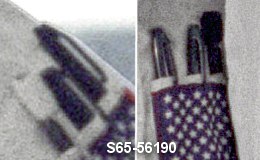
Details from Gemini 6 suiting exercises photo - Stafford on the left, Schirra on the right Pens and pencils can be seen quite clearly in the spacesuit shoulder pockets of Gemini 9 commander Tom Stafford and Gemini 12 pilot Buzz Aldrin in post-recovery photos from their respective missions, as shown in the details on the left. On the right are details from a photo showing the Gemini 6 crew during suiting-up exercises. A variety of pens and pencils can be seen in the shoulder pockets of their space suits. At the right-hand end of Aldrin's pocket, the left end of Stafford's Gemini 6 suit and the right-hand end of Shirra's pocket are what appear to be standard black Scripto pencils (with black or white velcro wrapped around the tops). The various pens visible are a mystery. Stafford (Gemini 9) and Alrdin (Gemini 12) appear to be carrying a metal-bodied marker pen of some kind. For Gemini 6 they seem to be carrying a number of black marker pens which may well be Pentel models. What's clear is that several different marker pens were carried on Gemini flights. Availability - Apart from Cooper's "Sign" pen sold at auction in 1995 I've not seen any other marker pens from Mercury or Gemini flights offered for sale. | ||||||||||||||||||||||||||||
Fisher Space Pen - Apollo 7 onwardsFor Apollos 7 through 17 the stowage lists show that each crew member carried a data recording pen. This pen, used on all missions from Apollo 7 onwards, is better-known as the Fisher Space Pen.
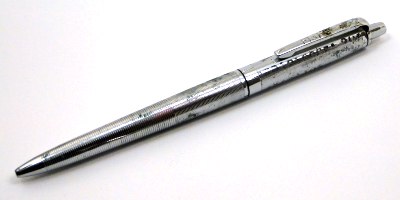
John Young's Apollo 16 flown Fisher Space Pen, model AG-7 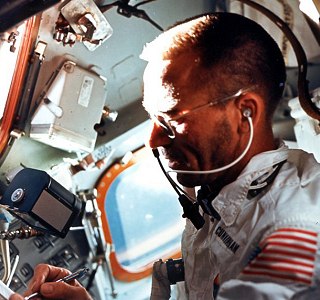
Walt Cunningham using a Fisher AG-7 pen on Apollo 7 The Fisher Space Pen was developed privately in the mid 1960s by the Fisher Pen Co., of Van Nuys, Ca, with NASA's requirements in mind. After extensive evaluation (from 1965 through 1967), NASA chose to use the Fisher model AG-7 on the space program. This retractable ballpoint pen featured a pressurized ink cartridge that allowed it to be used in zero gravity, and a special ink which was usable in a very broad range of temperatures, and in a vacuum. NASA apparently purchased 400 AG-7 pens in December 1967. These were referred to as configuration no. 204 and given the NASA part number SEB12100051-204. The pens were fitted with blue ink cartridges and had an end push button retractor. It is this configuration of pen that appears in the stowage lists for Apollo 7 through 17. Walt Cunningham (left) recalls that each Apollo 7 crew member carried two of these pens on the flight and indeed the Stowage Lists for Apollo 7 and Apollo 8 show 6 pens carried per flight. On Apollo 10 the Commander carried 2 Fisher pens but the other crew members carried none. On later flights one pen was carried per crew member. A few examples of an earlier configuration no. 201 were carried by some astronauts on their Apollo flights, with one example apparently carried by Wally Schirra on Apollo 7 (with serial number M16), and another apparently used by Jim Irwin on Apollo 15 (with serial number P7). On these pens the grooves on the casing run lengthwise along the body from the grip to the barrel whereas the 204 models have the grooves running crosswise. It seems possible that the 201 configuration pens carried by these astronauts were examples provided by Fisher during the initial evaluation process. For the Skylab project, the end push button units were replaced by a version with a side button retractor, which was given the designation 207 for the version with blue ink, and 208 for a version with black ink. Bill Pogue recalls that five or six of these pens were flown on Skylab III, quite likely one 207 and one 208 model per astronaut. The Fisher AG-7 207/208 model pens continued to be used on at least the early Shuttle missions, as evidenced by Jack Lousma's STS-3 flown Fisher Space Pen consigned to the June 2011 Heritage space auction. In total, around thirty eight Fisher AG-7 pens were flown on the Apollo missions. Of these, twenty nine were flown to the moon, including twelve or thirteen (Irwin apparently carried two) which were carried to the lunar surface in the lunar modules. Sadly, one of those pens, from Apollo 11 no less, was badly damaged in the 1978 San Diego Aerospace Museum fire. It's worth noting that the metal barrel of the upper section of the original AG-7 pens where it slides over the lower half is very thin. As a result, most vintage NASA-issue examples of this pen (including many of the Apollo flown examples sold to date) have fractured or cracked casings. FLOWN availability - A small number of Apollo-flown space pens have been sold to-date. Examples flown to Earth orbit on Apollo 7 and 9 have fetched in the $2-4k range in recent years. Examples flown to lunar orbit on Apollo 12 and 17 have sold for $2,700 to $3,500. Examples flown to the lunar surface have sold for anything from around $4,000 to nearly $24,000. Unflown availability - Unflown NASA-issue examples of this pen, generally used in training, are as difficult to find as flown examples with only four having appeared at auction in the last few years. 'Freebie' space pens given by Fisher to the astronauts (with their names engraved on them) are seen from time to time, but these are usually the later CH4 model with the clip attached to the side of the barrel rather than the AG-7 model used operationally by NASA. The Fisher Pen Co. is still going strong today, with its business based largely on the concept of the Space Pen. They still produce versions of the AG-7 pen and have produced numerous commemorative editions over the years. However, purists should note that the modern 'Original Astronaut Pen' has a side button retractor as used by NASA from Skylab onwards rather than the end push-button retractor that was actually used on the Apollo missions. The switch to the side button retractor mechanism was made prior to 1973 and possibly very soon after the original batch of end button retractor pens was delivered to NASA in 1967. The vast majority of vintage AG-7 pens I have seen online (e.g. on eBay) have side button retractors which implies that the end button versions may only have been available commercially for a short time. I've only seen two end button retractor examples sold on eBay in recent years (see example), and on both of these the pattern of grooves on the casing matches the '201' configuration. The Soviet space agency reportedly purchased 100 AG-7 pens in February 1969, although whether these were fitted with end or side button retractors is not clear. Of the 400 original pens acquired by NASA in 1967 around 38 were flown on the Apollo missions. Many of the remaining 362 pens would have been heavily used by the astronauts in training during the five years they were in active use. Given the propensity of the casings to crack it is likely that many of the original pens were disposed of by NASA over this period. In any case I have only seen four of these original unflown NASA-issue pens sold in the last few years. Other examples likely survived but their whereabouts are unknown. | ||||||||||||||||||||||||||||
Duro Marker Pen - Apollo 8 onwardsFor Apollos 11 through 17 the stowage lists show that each crew member also carried a marker pen.
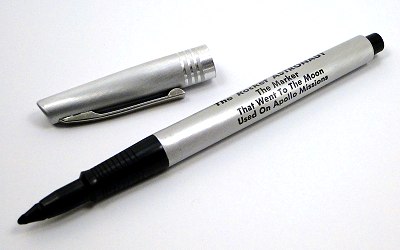
A commercial version of the DURO 'Rocket' Marker pen 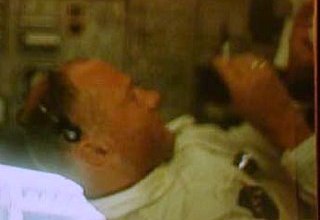
Buzz Aldrin using a Duro marker pen to make notations on board Apollo 11 during the trans-lunar coast. Although not as famous as the Fisher space pen, a lightweight aluminium felt-tip marker pen, made by the Duro Pen Co., of Brooklyn, New York, was used on all flights from Apollo 8 onwards (Walt Cunningham does not recall any marker pen being used on Apollo 7). The pen was marketed commercially as The Rocket Astronaut pen (by Duro or Amsterdam). It's worth noting that although it is often stated that a Fisher space pen was used to 'save' the Apollo 11 mission it was actually the lesser-known Duro marker pen that was used to trigger a broken circuit breaker for the Lunar Module ascent engine, as related by Aldrin in his book "Men from Earth". This was basically down to the fact that the tip of the pen happened to fit into the slot, but presumably it also seemed more sensible to poke a felt tip into the live circuit breaker rather than the metal point of a Fisher pen. On Apollo 11 through 17 each crew member carried one marker pen. On Apollo 10 the Commander carried one and the LMP carried two whilst the CMP carried none. In total, twenty seven of these Duro marker pens were flown to the moon on board the Apollo lunar missions, and twelve of those twenty seven pens were carried to the lunar surface in the lunar modules. One of these lunar-flown pens actually didn't complete the trip back to Earth as it drifted out of the Apollo 17 Command Module hatch at the start of Ron Evans' trans-Earth EVA. Since Ron Evans' own Apollo 17 flown marker pen was recently sold it stands to reason that the lost pen was actually one of the two surface-flown pens issued to either Gene Cernan or Harrison Schmitt, which leaves only eleven surface-flown marker pens. UPDATE: Details given in the current resale of the marker pen originally sold via the Novaspace Ron Evans garage sale may change the above assumption. The auction listing suggests that the pen sold by Evans was actually gifted to him by Cernan, implying that it was Evans' own pen which was lost at the start of his EVA. This remains to be clarified, something that is not made any easier by the fact that the serial number on the pen has been lost over the years. The stowage list is no help in this respect as this only shows the generic part number of the Duro marker pens. Bill Pogue recalls that five or six of these marker pens were flown on the Skylab III mission but they were not a great success on the long duration mission as they dried out quickly in the low pressure and low humidity of Skylab. The Duro marker pen continued to be used on at least the early Shuttle missions, as evidenced by Jack Lousma's STS-3 flown writing instruments consigned to the June 2011 Heritage space auction. FLOWN availability - A very small number of Apollo-flown marker pens have been sold to-date, as well as a few NASA-issued traning versions. An example flown to Earth orbit on Apollo 9 sold for $2,271, examples flown to lunar orbit have sold for $2,750 and $3,055, and John Young's lunar surface flown example from Apollo 16 sold for $8,365. Unflown availability - Unflown NASA-issue examples of this pen are very scarce - I've only seen four such pens sold to-date.
The company that made these marker pens no longer exists, but it is sometimes possible
to track down vintage commerical versions of the pen (as shown above) which, apart from the applied graphics and text, are identical in design to those used on the missions. | ||||||||||||||||||||||||||||
Garland Mechanical Pencil - Apollo 11 onwardsFor Apollos 11 through 17 the stowage lists show that in addition to a data entry pen and marker pen, each crew member carried a mechanical pencil. In fact, despite the worldwide fame of the Fisher Space Pen it is probably the humble Garland mechanical pencil that was the most heavily-used writing instrument on the Apollo missions.
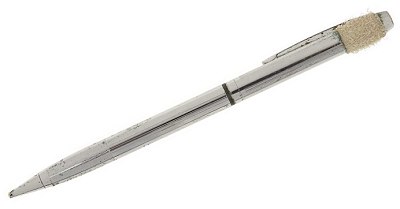
John Young's Apollo 16 flown Garland mechanical pencil Although on Apollo 7 the plastic-bodied Scripto mechanical pencils familiar from the Gemini project were still used, for later missions (from at least Apollo 9 onwards) a metal mechanical pencil manufactured by Lew Manufacturing Co., of Coventry, Rhode Island, was introduced. This pencil was sold commercially as the Garland 35-P. The issue of pencil leads breaking off and floating around in zero-g doesn't seem to have been a problem during the Gemini or Apollo missions. Bill Pogue stated that he never saw any broken leads floating around during the 84 day Skylab III mission (on which five or six of these pencils were flown), and believed that any such loose debris would have been quickly drawn into the Skylab air duct system and safely collected in the return filter. According to the stowage lists, on Apollo 11 through Apollo 17 each crew member carried one mechanical pencil, but on Apollo 9 four pencils were carried, and on Apollo 10 although the Commander carried one, the Lunar Module Pilot carried three, and the Command Module Pilot carried five pencils. If we follow the stowage lists we can say that thirty three Garland mechanical pencils were flown to the moon on board the Apollo lunar missions, and twelve of these pencils were carried to the lunar surface in the lunar modules. However, despite only one pencil being noted in the stowage lists as carried by the LMP on Apollo 15, two pencils identified as having been flown to the lunar surface by Irwin have been sold over the years - one in a private sale in 1989, and the other as part of his estate at Odyssey in 1994. It's worth noting that there are also two Fisher space pens identified as flown to the lunar surface by Irwin where again the stowage lists only show one being carried. The conclusion seems to be that it was possible for the astronauts to carry additional writing instruments (as detailed further below) making it difficult to ever determine the exact number flown. One lunar-flown pencil was lost out of the Apollo 16 Command Module hatch during Ken Mattingly's trans-Earth EVA. At the time John Young seemed to think it was his pencil that had floated out but both Young and Duke have since sold their lunar surface flown Garland pencils, indicating that it was Mattingly's that got away. The Garland pencil continued to be used on at least the early Shuttle missions, as evidenced by Jack Lousma's STS-3 flown writing instruments consigned to the June 2011 Heritage space auction. FLOWN availability - As with the space pens and marker pens, a small number of Apollo-flown Garland pencils have been sold to-date, as well as a few NASA-issued traning versions. Examples flown to lunar orbit have sold for between $3,407 and $7,170, and an example flown to the lunar surface was recently sold for just over $10,000. Unflown availability - Unflown NASA-issue examples of this pencil are extremely rare - I've only seen three examples sold to-date. Tracking down a vintage non-NASA example of the 35-P pencil is not much easier but they can sometimes be found. The company (now known as Garland Industries Inc.) still exists but they apparently stopped making the 35-P model not long after the Apollo era and have produced no commemorative version that I'm aware of. | ||||||||||||||||||||||||||||
Other Flown Pens/Pencils - Apollo missionsAs was mentioned earlier in this article, on the Gemini 3 mission the crew are known to have carried a number of Pentel pencils which, although space-qualified, were not mentioned part of the official spacecraft manifest and which did not carry NASA part or serial numbers. Post-flight photos from various Gemini missions also show the astronauts carrying a variety of pens which may not have been part of the official manifest. Although the stowage lists are very thorough as far as they go, the crews had some leeway to carry additional unmanifest personal equipment at their discretion. I know of at least three examples of pens carried on the Apollo missions that were not mentioned in the stowage lists:
A comment from Ken Mattingly in the Apollo 16 technical debriefing also seems to imply that the crew were carrying more than the three Garland pencils in the Stowage List: "You can really run out of pencils up there and then you're in trouble - Probably a spare pencil ought to get stuffed away somewhere. I wouldn't carry any more, but I'd take some of the ones you have onboard and stuff them away for use after you've lost all the ones you started with. We lost a couple out the hatch during EVA." The Garland pencils of both Young and Duke have been sold at auction, leaving only Mattingly's unaccounted for, so the loss of a couple of pencils implies more were carried, unless he is also referring to Fisher pens and markers. I mention this to highlight the important point that the story of flown items does not end with the stowage lists, or even with PPKs (which I understand to be quite vague in their detail) or any other existing documentation. In the end the best provenance for most flown items is usually the recollection and records of the astronauts themselves. Although it may be possible to get close, we will probably never have a definitive list of what was flown on the Mercury, Gemini and Apollo missions. Collectors are often surprised that NASA didn't keep a better record of such things but it's important to bear in mind that documenting flown souvenirs and even personal equipment was not the number one priority at NASA. As long as the items in question did not jeopardize the safety of the mission the crews were allowed a certain flexibility. | ||||||||||||||||||||||||||||
|
Annex A: Mercury & Gemini flown pens & pencils sold at auction or identified in private or museum collections Annex B: Apollo flown ballpoint pens sold at auction or identified in private or museum collections Annex C: Apollo flown marker pens sold at auction or identified in private or museum collections Annex D: Apollo flown mechanical pencils sold at auction or identified in private or museum collections | ||||||||||||||||||||||||||||
|
[1] 4 marking pens (CF55050-1), 4 mechanical pencils (CF55051-1 or -2) and 2 astronaut retractible pencils (CF55031-1 & -2) are noted in the Crew Equipment Lists for Gemini 10 in the Flight Readiness Review Report - Spacecraft 10 and for Gemini 11 in the Gemini Press Reference Book. | ||||||||||||||||||||||||||||
|
Legal Disclaimer: While every effort is made to ensure that the content of this website is accurate, the website is provided as is and I make no representations or warranties in relation to the accuracy or completeness of the information found on it. Nothing on this website should be taken to constitute professional advice or a formal recommendation and the author excludes all representations and warranties relating to the content and use of this site. In no event shall the author be liable for any incidental, indirect, consequential or special damages of any kind, or any damages whatsoever, including, without limitation, those resulting from loss of profit, goodwill, income, or anticipated savings, whether or not advised of the possibility of such damage, arising out of or in connection with the use of this website or any linked websites. | ||||||||||||||||||||||||||||